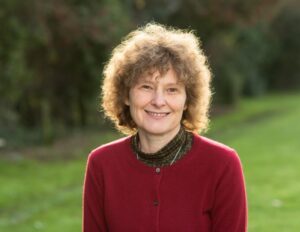University of Oxford
11a Mansfield Rd
OX1 3SZ
UK

In order not to be overwhelmed, we need to start small and focus on keeping our own nature healthy and resilient. Where I live, we treasure our beech woods. They are full of fungi and golden leaves now, but will have a carpet of scented bluebells in the spring. Here, people can help their local nature in many ways; by building ponds and keeping parts of our gardens wild, using as little pesticide, peat and artificial fertiliser as possible, making sure that we leave places for small creatures to hide away during winter.
Thinking a bit more broadly, we can support local conservation organisations who are working to restore and connect natural areas, and we can show our appreciation to our local farmers who, even in difficult circumstances, manage their land sympathetically for nature. We can contribute to local and regional planning processes and make our views about deforestation, overfishing and factory-farmed foods known in supermarkets and restaurants. It may be a bit awkward to ask waiters to ask the chef if the fish is MSC-certified, but if people consistently do this, the message gets through!
This still may seem a bit limited, but systems do shift as a result of the accumulation of many people’s small actions. For example, a couple of decades ago free range eggs were a niche product in the UK, high priced and only bought by those who could afford them and were committed to animal welfare. Now, they are the default eggs on sale in our supermarkets (just try to find battery-farmed eggs next time you shop). Certified palm oil and fish are moving in the same direction. One of the biggest actions anyone can take to reduce their impact on the planet is to change diet – for example buying local, pasture-fed meat, and less of it, rather than industrially-farmed meat fed on imported soy (which is a prime contributor to the destruction of nature overseas as well as climate change).

This may still seem far away from COVID-19, and from the wildlife trade which possibly caused the transfer of the virus to humans. But it’s all part of the same pattern of humanity’s destructive relationship with nature. This is something which all of us in the UK are complicit in, with our overconsumption and reliance on cheap imported food and goods. These then lead to overextraction of resources, pollution, land clearance, and thence to more disease transmission – coming back to bite us. As Gerald Durrell said, “The world is as delicate and as complicated as a spider`s web, and like a spider`s web, if you touch one thread, you send shudders running through all the other threads that make up the web. But we`re not just touching the web, we’re tearing great holes in it“.
As a conservation scientist, this realisation is part of my everyday working life. It’s also visible all around us, even here in our relatively cocooned existence. But I also come across many inspirational stories of people around the world who are turning the tide. Nature can bounce back rapidly if we can only bring ourselves to take our foot off the accelerator. I started the ConservationOptimism.org movement a few years ago to share these stories of hope; it’s vitally important to see that change can happen so as to be galvanised to keep going. Responding to COVID-19, I and colleagues from around the world started a new website called Pledgeforourfuture.earth, so that people who wanted to make a difference for nature could get inspiration and record their commitment to do things differently. Do take a look!
The phrase “Think Globally, Act Locally” is hackneyed, but that’s because it’s true. There are myriad ways to contribute to global nature recovery. But we all have things that we can do in our own neighbourhoods, individually and together, to maintain and restore our local nature. Importantly, we can make time to enjoy the nature around us, and notice the little things that mark the turning of the seasons; I’ve been loving watching the fieldfares which have just arrived in our garden as winter visitors from the east, and am looking forward to the snowdrops which will emerge in February. As the days gradually lengthen here, maybe we will also see new hope for the nature around us and further afield.

Thomas Hardy put it like this at the turn of the last century:
“…So little cause for carolings
Of such ecstatic sound
Was written on terrestrial things
Afar or nigh around,
That I could think there trembled through
His happy good-night air
Some blessed Hope, whereof he knew
And I was unaware.”
The difference for us is that we are aware – we just need to act on that awareness.
Join the PledgeForOurFuture team for an inspiring online discussion on December 3rd at 5-6pm GMT: ‘What can I do to help?’ Where we’ll be offering hope by bringing people together around the world to discuss how we can reset our relationship with nature.

